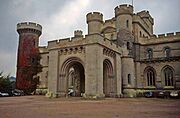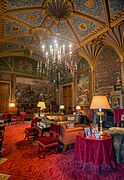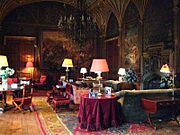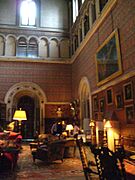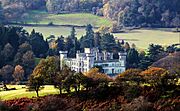Eastnor Castle facts for kids
Quick facts for kids Eastnor Castle |
|
|---|---|
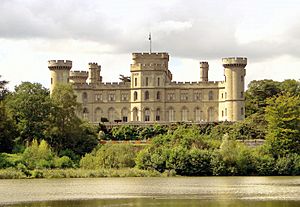 |
|
| Type | Mock castle |
| Location | Eastnor, Herefordshire |
| Built | 1811-1820 |
| Architect | Robert Smirke |
| Architectural style(s) | Gothic Revival |
| Governing body | Privately owned |
|
Listed Building – Grade I
|
|
| Official name: Eastnor Castle | |
| Designated | 18 November 1952 |
| Reference no. | 1156712 |
|
Listed Building – Grade II
|
|
| Official name: Castle lodge and gates | |
| Designated | 10 January 1986 |
| Reference no. | 1156692 |
|
Listed Building – Grade II
|
|
| Official name: Portcullis lodge and retaining walls to the forecourt of Eastnor Castle | |
| Designated | 10 January 1986 |
| Reference no. | 1082629 |
|
Listed Building – Grade II
|
|
| Official name: Retaining wall to Lower Terrace on garden front of Eastnor Castle | |
| Designated | 10 January 1986 |
| Reference no. | 1082630 |
|
Listed Building – Grade II
|
|
| Official name: Retaining wall to Upper Terrace on garden front of Eastnor Castle | |
| Designated | 10 January 1986 |
| Reference no. | 1349512 |
| Lua error in Module:Location_map at line 420: attempt to index field 'wikibase' (a nil value). | |
Eastnor Castle is a grand building in Eastnor, Herefordshire, England. It looks like an old medieval castle but was actually built much later, in the 1800s. This type of building is called a "mock castle."
The castle was built for John Cocks, 1st Earl Somers. He hired a famous architect named Robert Smirke. Smirke later became well-known for designing the British Museum.
Construction of Eastnor Castle took place between 1811 and 1820. Later, in 1849–1850, another famous designer, A. W. N. Pugin, added beautiful decorations inside. Eastnor Castle is still a private home today. It is currently lived in by James Hervey-Bathurst, who is the grandson of Arthur Somers-Cocks, 6th Baron Somers. The castle is considered a very important historical building, known as a Grade I listed building. Its gardens and parkland are also special, listed as Grade II*.
Contents
The Story of Eastnor Castle
How the Castle Came to Be
The land where Eastnor Castle stands was bought by the Cocks family in the late 1500s. Over time, through marriages, the family gained more wealth. This wealth helped them build the impressive castle we see today. It was designed to look like the strong medieval castles that once guarded the border between Wales and England.
Building and Changes Over Time
The castle was built following the plans of Robert Smirke from 1812 to 1820. A.W.N. Pugin made some changes inside. He decorated the Gothic drawing room in 1849–1850. Later, in the 1860s, George E. Fox made even more changes.
The castle is made of cut stone blocks. Its roof is hidden behind a wall with battlements, which makes it look like a real fortress. Iron was used for the roof and floor supports. Building the castle cost a lot of money back then.
What People Thought of the Castle
Not everyone loved the castle when it was first built. A writer named Charles Locke Eastlake criticized it in the 1800s. He said it looked "massive and gloomy." He also thought the small, narrow windows made it inconvenient to live in. He felt it might have been a good fort before gunpowder was invented, but as a home, it was a "mistake."
Life at the Castle Today
Eastnor Castle still has an old flour mill that works. It was built in the 1700s. In recent years, the water supply to the mill was fixed, and its machinery was repaired. This means the mill can now operate again.
As of 2020, the family living in the castle uses only a small part of it. James Hervey-Bathurst, who inherited the castle in 1988, mentioned that they mostly live in the kitchen, which was made bigger in 1992.
The castle's business was affected for a while in 2020 due to the global pandemic. However, by mid-July 2020, things started to get better. An old iron bridge over the weir, first built in 1828, was restored and reopened in 2021. Today, the castle is open for public tours during certain months. It is also a popular place for weddings.
Eastnor Obelisk
In 1812, John Somers-Cocks, 2nd Earl Somers ordered a tall stone monument called an obelisk to be built on the Eastnor estate. This obelisk was made to honor different members of his family. It was most likely designed by Robert Smirke, the same architect who designed the castle.
The obelisk has plaques that remember family members like John Somers, 1st Baron Somers. He was an important advisor to King William III. Another person remembered is Edward Charles Cocks. He was an intelligence officer who died during a battle in Spain in 1812. The obelisk is located in Eastnor Deer Park, about a mile from the castle. It is also a special historical monument, listed as a Grade II* listed building.
Eastnor Castle in Media
The Eastnor estate is a popular place for different activities and filming. The car company Land Rover uses the estate for customers to test-drive their vehicles.
The castle has also been a filming location for many movies, TV shows, and music videos. Some of these include:
- One More Time (1970), starring Peter Lawford and Sammy Davis Jr.
- The Slade music video "Run Runaway"
- The 1986 film The Canterville Ghost
- The BBC TV show Little Lord Fauntleroy (1995)
- The American reality show The Amazing Race
- ITV's 2015 show Doctor Thorne
- Two episodes of HBO's Succession
Gallery


